Super Pepe (SUPEPE) is a 2025 meme coin with a charitable twist. In this post, you will discover some realistic price scenarios, a...
Best Low Cap Crypto in 2025: Top Undervalued Coins with Growth Potential
 39 mins
39 mins Our analysis suggests that the best low cap crypto in 2025 is Bitcoin Hyper, a Layer 2 and DeFi solution for Bitcoin.
This project aligns with the continued institutional demand for BTC. The US government CLARITY and GENIUS Acts remove regulatory uncertainties, making DeFi an important sector for growth. Our research shows that FLUID stands out due to its use case of crypto borrowing and lending.
The ETH price has risen significantly, so growth for ERC-20 coins is likely. PEPENODE is a potential contender.
We selected these and other coins based on our detailed research methodology, which includes surveying over 60 coins, examining market signals, project communities, teams, tokenomics, use cases, and more.
Best Low Market Cap Crypto Coins to Watch in December 2025 – Top Picks

- First Bitcoin Layer 2 enabling fast, low-cost transactions
- Fixes Bitcoin’s speed and fee limitations with near real-time performance
- Enables a Bitcoin-native DeFi ecosystem

- Degen meme coin inspired by max-leverage trading
- A tribute to high-risk hustle — fueled by sweat and conviction
- Ethereum-born, culture-driven, aiming for multichain

- Build your own virtual meme coin mining rig.
- 100% virtual and requires no additional computing power.
- Top miners get additional bonuses in Pepe, Fartcoin, and other meme coins.

- AI-Powered Virtual Influencers
- 20% APY Staking Rewards
- VIP perks: livestreams, BTS content, credits, and more.
Key Takeaways
- Despite the October 11 sharp drop, crypto ETP inflows totaled $3.17B last week, according to CoinShares, suggesting no major fund outflows to worry low cap crypto investors.
- Bitcoin Hyper, a BTC Layer 2, has raised $29.03M, indicating growth potential, despite the recent decline in BTC BTC $91 470 24h volatility: 2.1% Market cap: $1.83 T Vol. 24h: $31.30 B .
- Maxi Doge and PEPENODE sit inside a meme sector worth $50.3B (Snapshot from CoinGecko, November 20, 2025), which has rebounded after the recent broader crypto market pullback.
- REI network and Hash AI are low-cap plays set to benefit from growing global adoption of AI, which has a CAGR of 35.9%, according to Founders Forum Group.
- To pick best low cap crypto focus on real use cases, audited smart contracts, and consistent community engagement, track unlock schedules, and verify liquidity locks on DEXs.
Top 10 Low Market Cap Crypto List in 2025
After analyzing the market and applying our detailed methodology, we have selected these 10 coins as promising for December [curyear] and beyond. Well-timed investments and risk diversification are key.
- Bitcoin Hyper (HYPER) – BTC Layer 2 scaling solution using Solana’s virtual machine
- Maxi Doge (MAXI) – Low-cap Dogecoin spin-off dedicated to building a degen trading community
- Fluid (FLUID) – DeFi platform offering lending, borrowing, and swaps
- PEPENODE (PEPENODE) – First mine-to-earn memecoin
- REI Network (REI) – Gasless high-speed blockchain with AI integration
- ZetaChain (ZETA) – Omnichain Layer 1 enabling native cross-chain DeFi and messaging
- Hash AI (HASHAI) – AI-powered and optimized crypto mining company
- SUBBD (SUBBD) – Fan and influencer co-creation platform on web3
- Celestia (TIA) – Modular data-availability blockchain for rollups
- ApeCoin (APE) – DAO token powering the BAYC and metaverse ecosystem
Best Low Cap Crypto Gems with Potential – Analysis and Reviews
Here are 10 of the best low-cap crypto that our analysis uncovered. These opportunities may be suitable for those seeking high-risk, high-reward, low-market-cap plays.
1. Bitcoin Hyper (HYPER) – First BTC Layer 2 Built on Solana
Bitcoin Hyper is a Layer 2 for Bitcoin based on Solana’s Virtual Machine (SVM). The project aims to reduce transaction fees and enable dApps, DeFi, and fast payments on BTCs. Holders can stake HYPER to earn APYs of 40%, participate in governance, and pay gas fees.
Our view (Julia Sakovich): Bitcoin Layer 2 has become one of the main trends of 2025 and this market cycle as a whole. HYPER aligns with that narrative and, in my view, offers genuine utility. Despite its strong potential, the risks remain high, as always in crypto.
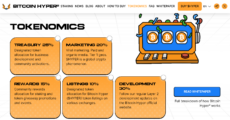
A large portion of Bitcoin Hyper’s tokenomics is dedicated to treasury and marketing. Source: Bitcoin Hyper
Bitcoin Hyper details:
- Why It’s Promising: Over $290B is locked in DeFi; HYPER positions Bitcoin to access part of it.
- Suitable For: BTC bulls, Layer 2 fans, DeFi and infrastructure plays.
- Caveats: There are several BTC Layer 2s on the market, including Stacks STX $0.30 24h volatility: 0.3% Market cap: $549.17 M Vol. 24h: $12.25 M , which brings competition.
| Category | Bitcoin Layer 2 / DeFi |
| Chain | Proprietary (Bitcoin Layer 2) |
| Audited? | Yes (Coinsult, Spywolf) |
| Market Cap | $29.03M raised |
| Community | >6.4k across Telegram |
| Price | $0.013375 |
| Next Increase | Loading...
|
2. Maxi Doge (MAXI) – Low-Cap Dogecoin Spin-Off Dedicated to Building a Degen Trading Community
Maxi Doge is a dog-based memecoin that satirizes the degen high-leverage trading culture. It draws on the narrative of established coins like Dogecoin DOGE $0.14 24h volatility: 1.7% Market cap: $23.02 B Vol. 24h: $963.66 M and Shiba Inu SHIB $0.000009 24h volatility: 1.3% Market cap: $5.04 B Vol. 24h: $91.86 M , but with a humorous gym-bro aesthetic. The MAXI token offers staking opportunities, with an APY of 72%.
Our view (Otar Topuria): Unlike NFTs, clicker games, and other short-lived trends, memecoins are here to stay. As usual, the main risk is their dependence on hype. I believe the Doge connection and humorous mascot will keep Maxi Doge popular, but investing in low cap tokens always comes with significant risk.

Maxi Doge allocates 40% of its total token supply to marketing efforts. Source: Maxi Doge
Maxi Doge details:
- Why It’s Promising: Dogecoin is among the top 10 (Snapshot from CoinGecko, November 19, 2025), showing the potential of doge-coins.
- Suitable For: Meme coin traders, small cap flippers, Dogecoin investors, leverage traders.
- Caveats: MAXI may keep its momentum or lose traction over time.
| Category | Meme Coin |
| Chain | Ethereum |
| Audited? | Yes, according to the whitepaper |
| Market Cap | $4.28M raised |
| Community | Over 8K followers on X and Telegram |
| Price | $0.0002715 |
| Next Increase | Loading...
|
3. Fluid (FLUID) – Multi-Chain DEX, Lending and Borrowing DeFi Protocol
Fluid is a multi-chain DeFi protocol that provides decentralized lending, borrowing, and a DEX. Users receive APYs for supplying assets. The FLUID token grants holders governance rights and rewards users who provide liquidity or stake assets. It is used for transaction fees, buy-backs, and burns to help stabilize the price.
Our view (Julia Sakovich): The fundamental value of FLUID rests on two pillars: cross-chain lending and DEX functions. However, the project still carries risks related to competition and token unlocks. There’s no guarantee FLUID will deliver significant growth, but I think it could be a reasonable addition to a diversified investment portfolio.
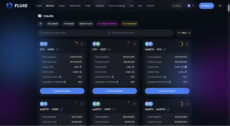
Fluid offers a 5.06% borrow rate for the ETH/USDC trading pair. Source: Fluid
Fluid details:
- Why It’s Promising: FLUID has $1.8 billion in TVL (Snapshot from Defi Llama, November 19, 2025). DeFi lending attracted $53B in Q2 2025.
- Suitable For: DeFi traders, borrowing plays, Solana, Ethereum, Base, and Arbitrum fans.
- Caveats: The price may face pressure from token unlocks.
| Category | DeFi Protocol / Multi-chain DEX, Lending and Borrowing |
| Chain | Ethereum, Arbitrum, Polygon, Base, Solana via Jupiter Lend |
| Audited? | Yes, core contracts and liquidity layer are documented and designed for security |
| Market Cap | $311 million |
| Community | 37.7K X followers |
| Price | FLUID $3.24 24h volatility: 0.8% Market cap: $250.46 M Vol. 24h: $3.98 M |
4. PEPENODE (PEPENODE) – First Mine-to-Earn Memecoin
PEPENODE is a memecoin on Ethereum and a virtual mining crypto game that will launch after the TGE. Players will use PEPENODE to build custom mining rigs, earn rewards, and participate in airdrops. For now, it offers staking with 570% APY.
Our view (Otar Topuria): Every project wants to stand out, but PEPENODE actually manages to do it. The developers have combined GameFi and memecoins with a mine-to-earn system. The main threat to the project, I guess, is the rapid loss of player interest after launch.

PEPENODE’s mine-to-earn game is scheduled to launch right after the TGE. Source: PEPENODE
PEPENODE details:
- Why It’s Promising: The game is targeting the $50.3B memecoin market (Snapshot from CoinGecko, November 20, 2025).
- Suitable For: Gaming enthusiasts, APY hunters, memecoin traders, and early-stage investors.
- Caveats: Success will depend on keeping players engaged and attracting new miners.
| Category | Memecoin / Virtual Mining |
| Chain | Ethereum (ERC-20) |
| Audited? | Smart contract-based transparent mechanics |
| Market Cap | $2.28M raised |
| Community | Over 7.5K followers on X and Telegram |
| Price | $0.0011778 |
| Next Increase | Loading...
|
5. REI Network (REI) – Fast Gassless Blockchain Targeting AI and High-Speed Applications
REI Network, formerly GXChain, is a PoS blockchain offering a lightweight, gasless solution for dApps, improving the way AI and crypto work together. It is designed to support high-speed industries that use micropayments, such as GameFi. REI holders can stake their tokens to help secure the network and earn up to 10% rewards, while also making on-chain transactions without gas fees.
Our view (Julia Sakovich): I was drawn to REI Network by its gasless transactions and AI integration. It seems the main risk lies in the development pace. However, if the testnet confirms the promised performance, it could turn out to be an excellent Layer 1 project.
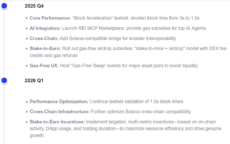
REI Network plans a Block Acceleration testnet in Q4 2025 to reduce block time. Source: REI Network
REI Network details:
- Why It’s Promising: The project targets the AI crypto sector with a market cap of $23B (Snapshot from CoinGecko, November 20, 2025).
- Suitable For: AI investors, Blockchain Layer 1 fans.
- Caveats: This project has been in development for several years, but it remains at an early stage.
| Category | Blockchain Token / AI / GameFi / DeFi / NFT |
| Chain | Proprietary (EVM compatible) |
| Audited? | Yes (Cyberscope) |
| Market Cap | $9.9M |
| Community | Active support with 127K X followers and over 45K Discord members |
| Price | [NC] |
6. ZetaChain (ZETA) – Omnichain Interoperability Layer Connecting All Blockchains
ZetaChain is an interoperability-focused Layer 1 designed to unify liquidity and messaging across all major blockchains, including Bitcoin, Ethereum, and Cosmos. It enables developers to build omnichain dApps that interact with assets on multiple chains without wrapping or bridging, reducing complexity and security risks. ZETA tokens are used for staking, gas fees, and securing the network through validator participation.
Our view (Julia Sakovich): Interoperability as a niche is in high demand within the crypto industry, and ZetaChain aims to natively integrate Bitcoin into cross-chain DeFi without custodial bridges. However, competition in this segment is intense, with alternatives like LayerZero, Axelar, and others. As for me, ZetaChain’s success will heavily depend on broader ecosystem adoption.
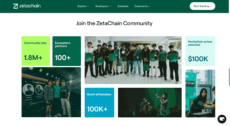
ZetaChain claims that its community includes more than 1.8 million participants. Source: ZetaChain
ZetaChain details:
- Why It’s Promising: Offers a unified cross-chain environment at a time when multi-chain liquidity is fragmented.
- Suitable For: Infrastructure investors, cross-chain DeFi users, developers building omnichain apps.
- Caveats: Strong competition from other interoperability protocols; adoption depends on dApp traction.
| Category | Interoperability / Layer 1 |
| Chain | ZetaChain (Cosmos-based) |
| Audited? | Yes (Hacken, CertiK) |
| Market Cap | $104M |
| Community | Over 1M followers on X |
| Price | ZETA $0.0862 24h volatility: 0.7% Market cap: $100.88 M Vol. 24h: $5.63 M |
7. Hash AI (HASHAI) – Crypto Mining Company Using AI to Maximise Short-Term Profit Opportunities
HashAI is a UK-based project focused on improving crypto-mining efficiency through AI-driven optimization and a rental model for rigs and nodes. It positions itself as a hybrid mining-plus-AI play, aiming to scale revenue by automating mining decisions and expanding hardware capacity.
Our view (Otar Topuria): In my opinion, AI is already deeply intertwined with cryptocurrencies. That’s why projects like HASHAI will play an increasingly important role in the crypto industry. Mining optimization is a valuable utility, but remember the risks tied to centralized control and physical infrastructure.

Hash AI users can choose from multiple nodes to utilize GPU power for their projects. Source: Hash AI
Hash AI details:
- Why It’s Promising: Hash AI could secure a leading position in the AI segment with a market cap of $23B (Snapshot from CoinGecko, November 20, 2025).
- Suitable For: AI and mining investments, RWA investors, high reward / high risk.
- Caveats: Success depends on physical infrastructure under construction.
| Category | AI / Mining / RWAs |
| Chain | Ethereum (ERC-20), Multi-chain Layer 1 Blockchains |
| Audited? | Yes (CertiK) |
| Market Cap | $13.5M |
| Community | Over 35K followers on X |
| Price | [NC] |
8. SUBBD (SUBBD) – AI and Fan Content Creator Platform
SUBBD is a SocialFi project that brings a Web2 network of content creators into blockchain and AI. The platform aims to keep fees low and make content production easier with AI tools, and it already includes 2,000 creators and 250K followers. The ecosystem runs on the SUBD token, which can be staked for APY.
Our view (Otar Topuria): SUBBD offers low fees, which is crucial for content creators. From my perspective, it’s a useful solution with the potential to attract the Web2 audience into the Web3 space. The main threat is user activity decline, so it’s worth weighing both the investment potential and the risks.

SUBBD roadmap highlighting the transition to phase 2. Source: SUBBD
SUBDD details:
- Why It’s Promising: A blend of SocialFi and AI in a single low-fee ecosystem for creators.
- Suitable For: AI-powered plays, Content/Fan business models.
- Caveats: Competition from social media is huge. Success will rely heavily on marketing.
| Category | AI / Creator Economy / Web3 |
| Chain | Ethereum |
| Audited? | Yes (SolidProof and Coinsult) |
| Market Cap | $1.38M raised |
| Community | Over 82K followers, 2,000 top influencers |
| Price | $0.0571 |
| Next Increase | Loading...
|
9. Celestia (TIA) – Modular Blockchain for Data Availability and Rollups
Celestia is the first modular blockchain focused exclusively on data availability (DA). Instead of requiring each chain to handle execution, settlement, and DA, Celestia separates these layers, letting developers deploy lightweight rollups that inherit Celestia’s DA guarantees. The TIA token is used to pay for blockspace and participate in staking, contributing to network security.
Our view (Julia Sakovich): Celestia became one of the first major players in the modular blockchain segment, which has significantly reshaped the crypto industry in recent years. I’m confident that the project’s potential is closely tied to the growth of rollups. I believe demand for TIA could increase substantially in the coming years, but it’s important to factor in competition from EigenLayer.

Celestia offers node-running options for beginners, intermediate, and advanced users. Source: Celestia
Celestia details:
- Why It’s Promising: Modular DA is an emerging narrative with real usage from rollups and L2s.
- Suitable For: Infrastructure-focused investors, rollup builders, long-term Layer 2 ecosystem watchers.
- Caveats: Competes with Ethereum’s DA solutions and emerging modular frameworks.
| Category | Modular Data Availability / Infrastructure |
| Chain | Celestia |
| Audited? | Yes (CertiK, Cyberscope) |
| Market Cap | $528 million |
| Community | Around 400K followers on X and Telegram |
| Price | TIA $0.58 24h volatility: 0.1% Market cap: $497.35 M Vol. 24h: $68.11 M |
10. ApeCoin (APE) – DAO-Governed Token Powering the Bored Ape Ecosystem
ApeCoin is the governance and utility token behind the Bored Ape Yacht Club (BAYC) ecosystem. APE holders can vote on ApeCoin DAO proposals and access exclusive events, games, and services. The token’s use case extends to Web3 apps built by third parties, enhancing its role as a cross-platform asset within the NFT economy.
Our view (Otar Topuria): ApeCoin was designed as a logical extension of the Yuga Labs ecosystem and the popular Bored Ape Yacht Club NFT collection. Considering it’s 98.8% below its all-time high (Snapshot from CoinGecko, November 19, 2025), I see it as a potential opportunity for strong upside. However, it’s important to remember that the NFT sector has already gone through a crash, and its recovery pace remains uncertain.

Buying ApeCoin is a way to join the hyped BAYC ecosystem through a low cap crypto. Source: BAYC
ApeCoin details:
- Why It’s Promising: BAYC is a strong Web3 brand with $3.3 billion in all-time sales volume and 6,163 NFT owners (Snapshot from CryptoSlam, November 19, 2025).
- Suitable For: NFT investors, metaverse enthusiasts, DAO participants.
- Caveats: Market sentiment around NFTs has cooled, making price momentum slower.
| Category | DAO / NFT / Metaverse |
| Chain | Ethereum (ERC-20) |
| Audited? | Yes (CertiK; on-chain transparency reports) |
| Market Cap | $344M |
| Community | Around 470K followers on X |
| Price | APE $0.23 24h volatility: 2.2% Market cap: $212.50 M Vol. 24h: $23.80 M |
What Users Say
Retail traders on Reddit often view low-cap cryptocurrencies as high-variance plays: they are cheap enough for asymmetric upside, but risky due to low liquidity and rapid sentiment shifts. Discussions typically focus on catalysts, liquidity depth, token unlocks, and community strength rather than fundamentals.
- ApeCoin: Some Reddit users advise against buying ApeCoin, complaining about lost investments and even calling it a “dead coin”. Others, however, believe that APE “could make a surprising comeback when the alt season starts”.
- Hash AI: According to Reddit users, HASHAI is described by some as an “undervalued runner for the super cycle”, while others call it “pure garbage”. There are also threads discussing issues with withdrawing the token on Poloniex.
- Fluid: A Reddit user said he plans to use Fluid for DeFi strategies because it seems like an “interesting project”. In the comments, others confirmed borrowing cbBTC using Fluid and called it a “good protocol”.
While community opinions help map short-term sentiment, they are often inconsistent and can shift without warning. Crowd expectations rarely align with real market performance, so Reddit discussions offer context rather than dependable signals.
Why 2025 Is Big for Low Cap Crypto
In the first days of November, Bitcoin hovered near $110,000 before slipping into a consolidation trend. It dropped under the key $100,000 mark on November 5, and by November 18 it had dipped below $90,000 for the first time since April 2025.
Bitcoin’s market share remains elevated, but BTC dominance is hovering below 60%, a level that historically precedes rotations into low cap crypto when it starts to roll over.
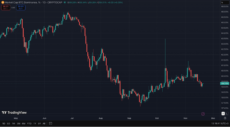
Bitcoin’s dominance is decreasing on the weekly chart. Source: TradingView
In April 2025, the SEC approved Ether ETF options, which opened access to more products and altcoin exposure. Since then, institutional interest has stayed solid. In November, U.S. spot Bitcoin ETFs shifted to heavy mid-month outflows (Snapshot from SoSoValue, November 20, 2025).
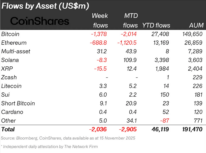
High outflows for Bitcoin spot EFTs in mid November 2025. Source: CoinShares
Venture capital is also returning: according to Galaxy, crypto VCs invested $1.9 billion in Q1 2025, the highest since 2023. Retail attention has shifted toward Telegram bots, DeFi, and Layer 2 ecosystems, with DeFi TVL rebounding above $170 billion mid-year.
Alt-season setups form when BTC dominance stalls and new liquidity flows down the risk curve. For low cap crypto investors, that means both higher volatility and higher upside, but only for projects with credible teams, tokenomics, and real on-chain traction.
Early Signs of Low Cap Crypto with High Potential
There are several recurring signals that a low-cap crypto may have breakout potential. Below are the ones we monitor, with real-world examples and links to support each.
Trending Narratives
When a narrative begins appearing across multiple channels (Google Trends, Messari, TradFi reports, and social media), it usually signals rising interest. At that point, users typically start looking for new crypto projects or simply crypto under $1.
A Bigger Cap Coin with a Similar Idea Is Mooning
When a larger token within the same theme starts rallying, traders often search for the best cheap crypto to buy and the next crypto to explode. Such tokens can show daily volatility of 20% or more, especially as trends around Bitcoin and other coins strengthen.
Big Partnership or Hints at Institutional Adoption
A low-cap project gaining institutional or mainstream partnerships can radically increase legitimacy and visibility.
For example:
Circle and Fireblocks recently announced a partnership aimed at boosting institutional USDC adoption via infrastructure integration.
Ripple expanding into Bahrain with Fintech Bay, signaling institutional and regional adoption moves.
Regulatory Issues or Changes
Regulation can both suppress and empower certain cryptos. For example, XRP’s long legal entanglements held it back, but now evolving U.S. policy (e.g. proposed clarity laws or stablecoin frameworks) could reopen growth paths.
High Community Engagement
Sometimes, a project takes off at the right moment. Suppose a project experiences strong community growth on social media or is consistently mentioned in crypto groups. This can be a sign that a low-cap crypto has high potential. Be aware of shillers who promote for money rather than belief.
Platform / Token Use Case
A token that has real utility (e.g., governance, fee burns, staking, revenue sharing) and sound tokenomics is more likely to sustain rallies. Among the best micro cap crypto picks, there are projects that are not just hype, they also emphasize functional utility, tokenomics, and development progress.
Low Market Cap Crypto That Exploded in the Past and What We Can Learn?
An analysis of past low-cap cryptocurrencies that surged thousands of percent reveals clear patterns. Meme tokens have repeatedly demonstrated outsized retail momentum. For example, PEPE surged more than 62,000% and BONK over 54,000% from launch to peak, while utility-driven tokens such as Kaspa gained over 110,000% thanks to technological innovation.
Historical data from CoinGecko and CoinMarketCap show that tokens with both tier-1 exchange listings and active communities tend to outperform peers, though timing remains highly unpredictable.
| Token | Launch Price (approx.) | Peak Price (approx.) | ROI (Launch to Peak) | Key Catalysts |
| Pepe (PEPE) | $0.000000001 (Apr 2023) | $0.00002803 (Dec 2024) | 62,070% | Tier-1 exchange listings, strong community, deflationary supply |
| Bonk (BONK) | $0.000000001 (Dec 2022) | $0.00005825 (Nov 2024) | 54,080% | Solana integration, large airdrops, major exchange listings |
| Kaspa (KAS) | $0.0001699 (Nov 2021) | $0.2076 (Aug 2024) | 110,000% | GHOSTDAG protocol, high throughput, decentralization focus |
| SPX6900 (SPX) | $0.001318 (Aug 2023) | $2.05 (Jul 2025) | 115,449% | Satirical branding, strong community engagement, deflationary tokenomics |
| Dogwifhat (WIF) | $0.001 (Nov 2023) | $4.83 (Mar 2024) | 488,900% | Solana ecosystem growth, rapid CEX adoption |
Time: Most took time to reach their all-time highs. PEPE peaked 19 months after launch, BONK after 23 months, and SPX6900 after roughly 23 months.
New Concept: Kaspa showcased the upside of genuine innovation, using DAG-based tech to support small-scale miners, a move that drove adoption and significant post-listing growth.
Overall, the biggest gainers were either meme tokens with viral energy or projects introducing new technical frameworks. In both cases, listings on tier-1 and tier-2 CEXs consistently acted as major catalysts for price appreciation.
How We Picked These Low-Cap Crypto Projects – Our Methodology
We screened 60+ low cap crypto, prioritizing projects under a ~$50M market cap, with a few larger exceptions for diversification. Each name was scored across the factors below, which sum to 100%. For a deeper dive into our scoring rules and update cadence, see the Coinspeaker methodology.
Low-Cap Screening & Liquidity – 25%
We focus on asymmetric upside with real tradability: circulating supply vs FDV, pool depth, basic slippage at common order sizes, and whether liquidity is locked or broadly provided.
Community & Social Velocity – 20%
We track verifiable growth across X, Telegram, and Discord, looking at follower momentum, repost ratios, unique account engagement, and the spread of narratives.
Tokenomics & Unlocks – 15%
We evaluate supply caps, allocations, vesting, emissions, treasury runway, and incentives for liquidity, listings, or user growth. Unsustainable unlock profiles are penalized.
Narrative Fit & Timing – 15%
Capital follows stories. We score alignment with active narratives such as Bitcoin L2, AI, Base/Solana ecosystems, and utility-led themes, plus the project’s timing within those cycles.
Early Utility & Roadmap Delivery – 10%
Shipping beats promises. Live products, working dashboards, bots, bridges, or staking modules earn credit, as does a visible cadence of public updates and repos.
Security, Audits & KYC – 7%
We note third-party audits, bug bounties, multisig details, and any formal KYC of core contributors where disclosed. Unaddressed critical findings reduce scores.
Exchange Coverage & Market Access – 5%
We consider DEX depth, aggregator routing, CEX presence or readiness, and realistic listing paths that could expand liquidity and discovery.
Transparency & Documentation – 3%
Clear whitepapers, docs, on-chain addresses, team disclosures, and straightforward explanations of risks and dependencies are rewarded.
What Is a Low Market Cap Crypto?
Low market cap cryptocurrencies are tokens with a market capitalization below $1 billion. Many emerging projects fall into this category, including early-stage Layer 2 networks, AI tokens, and meme coins with growing communities. These assets often attract investors seeking high-upside opportunities before broader market adoption.
To understand market cap, you simply multiply the token’s circulating supply by its price. For example:
10 billion tokens × $1 = $10 billion
1 million tokens × $1 = $1 million
This metric helps investors compare the relative size and maturity of different projects.
What is the price range of a low-cap crypto?
A low-cap crypto can trade at any price, from fractions of a cent to double digits. Price does not determine market cap; supply does.
While many low-cap tokens trade under $1, others with smaller supplies can have higher prices and still remain below the $1B market cap threshold. The defining feature is size, not price.
Projects under $1B are considered early-stage because they have room to grow, but they also face higher volatility and execution risk.
How do low market cap coins compare to traditional finance?
Market capitalization in crypto is similar, though not identical, to company valuations in traditional finance. The same balance between risk and reward applies:
Smaller, sub-$1B crypto projects resemble young or niche companies in the stock market.
They tend to have fewer users, limited liquidity, and lower public awareness.
However, they may also offer meaningful growth potential if the team executes well.
Like small-cap stocks, low-cap crypto assets can experience sharp price movements following news such as a major partnership, technological breakthroughs, exchange listings, unexpected community or narrative momentum.
But many projects peak early and fail to recover; there are no guarantees. Low-cap coins are typically more volatile than large, well-established assets and respond quickly to market sentiment.
Risk/Reward Tolerance with Low Capitalization Coins and Companies
Bigger companies, such as NVIDIA, and cryptocurrencies like XRP have produced high yields and proven products that are in demand. Like any business model, they are sensitive to risks, such as competition. However, they are more likely to hold or even accrue value than to lose it, unlike many smaller, newer businesses.
This makes them a possibly safer bet than small-cap cryptocurrencies, or at least a lower risk-to-reward ratio. Due to their large valuations or market caps, the growth potential for high-cap investors is significantly smaller than for low-cap investors who entered at discounted prices during crypto ICO and investor rounds.
This is often why crypto gem hunters seek low-cap coins – they believe they can see undervalued potential.
With big-cap coins, there is another risk: many investors entered at a lower price, which can create selling pressure. While the growth potential can be lower, it can be more reliable. Any trading comes with risk, and price action is unpredictable, but these stocks are considered blue-chip.
Risks and Rewards of Low-Cap Crypto in Trading
low-cap crypto offer investors the chance to bet on promising companies and crypto platforms that could have the potential to grow substantially over a relatively short period.
However, the risk is higher, as they may be unproven or have a small community and small market share.
They may also face stiff competition from other cryptocurrencies in the market.
They do offer a potential for greater reward if their project is successful, for early backers. Up to 100x is possible with a low-cap crypto that explodes.
Why a Low-Cap Crypto Can Explode
Many low-cap crypto projects will be new ventures, with their future technology still in development. Others may be up-and-coming projects that are beginning to mature in the market, gain attention, or have recently pivoted into a new space, such as low- to mid-cap COTI, for example.
COTI has shifted from a payments chain and released a new privacy-focused Layer 2 using garbled circuits, bringing it in line with the trending regulatory compliant privacy narratives of 2025.
These kinds of statuses and developments can be a way for a low-cap crypto to gain attention and potentially explode.
Volatility
Newer low-cap crypto coins with a smaller holder base can be easily subject to dramatic fluctuations in price, both up and down. If a large holder decides to sell, then that can bring down the cost. However, if the token and platform gain new adoption, this can lead to a massive price increase.
Medium-sized buys can have a big impact on tokens with a market cap of less than $50M, for better or worse.
Social Virality
Social virality and community support are important ways for early-stage low-cap coins to grow. And community members may become very loyal and vocal on social media.
New ideas, technological breakthroughs, and strong community engagement can attract new users and influencers to promising low-cap crypto, bringing more attention to potentially undervalued projects. If potential buyers see a lot of positive social mentions, they can feel incentivised to invest their capital.
Staking Rewards
Many new and early-stage coins and protocols offer high staking rewards, which is a way of increasing the size of your holdings. These are often provided for by a share of the tokenomics. The value, of course, depends on the coin’s future price action.
Token Burns
Token burns can help support or even increase the price of cryptocurrencies by reducing the supply. Both small and large projects often employ token burns, such as BNB or SHIB. But for smaller-cap coins, the effect is more dramatic.
Exchange Listings Impact
Many low-cap coins and ICOs launch on Web3 first, due to the lower barrier of entry. The price can fluctuate depending on market conditions, tokenomics, and various other factors. The ideal scenario is that the coin of choice rises due to increased demand and effective marketing, as new entrants discover the project; however, the result varies widely, with some coins rising dramatically and others falling dramatically.
The Coinbase and Binance Effect
As a coin gains traction, listing on a major CEXs often produces what’s known in crypto circles as the “listing pump.” A listing on Coinbase, Binance, or other tier-1/2 exchanges typically signals credibility, regulatory vetting, and access to deeper liquidity, all of which can trigger a sharp uptick in price and volume. That said, it’s not a guarantee of sustained success; many coins spike, then fade.
Binance’s September 11, 2025 listing announcement for Pump.fun (PUMP) triggered an almost 5% price pop within minutes, while Coinbase’s addition of KAITO to its perpetual futures lineup saw KAITO surge about 40% alongside a 128% jump in trading volume.
Coinbase’s support notice for POPCAT and PENGU had a similar effect: POPCAT rallied by more than 20% and PENGU climbed roughly 7% following the announcement that transfers were enabled with trading to follow. It clearly illustrates the listing-to-price reaction.
How to Find Low Cap Crypto
The best way to find low cap crypto is by checking new listings on CoinGecko, CoinMarketCap, DEXTools, or Jupiter Alpha. As they are decentralized, DEXtools and Jupiter will display more fresh pairs, but also some honeypot scam coins.
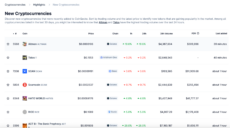
The new cryptocurrencies page on CoinGecko. Source: CoinGecko
Another option is to use a bot, which can provide details of new coins and even assist you in buying safely (but ensure you trust the bot and use a new wallet).
Many Telegram channels utilize bots that list new pairs, some of which are free. You could even make your own TG channel and have new pairs get listed.
You can also find crypto presales that will have a low market cap at launch.
How to Buy Low Cap Crypto
Once you find a project you want to explore, ensure your decentralized wallet (for example, Best Wallet, MetaMask, Zerion, or another trusted option) contains funds. If necessary, you can top up your wallet by onramping through a centralized exchange or an in-wallet fiat gateway.
Before buying, connect your wallet only to platforms you trust. Many new tokens are traded directly through DEX interfaces, so consider using a fresh wallet for added safety if you’re interacting with unknown contracts.
It’s crucial to verify the token contract address using reliable sources like CoinGecko or CoinMarketCap. Copy the contract address directly from the official listing to avoid counterfeit tokens. You can also run safety checks through TokenSniffer or GoPlus to identify red flags.
Review liquidity levels before entering a position. On-chain tools like DEXTools show liquidity pool size, lock status, and recent trading activity. Low-cap tokens often suffer from thin liquidity, which can make buying or selling more difficult.
Even if a token appears safe based on initial checks, remember that new and low-cap assets carry elevated risks, including volatility, low liquidity, and potential contract exploits.
Where to Buy the Best Low-Cap Crypto
Buying low-cap cryptocurrencies typically occurs through decentralized exchanges (DEXs), often before they are listed on larger centralized exchanges (CEXs).
Decentralized Exchanges
These are the main venues for new or smaller tokens, enabling direct peer-to-peer trading. You’ll need a compatible decentralized wallet (e.g., MetaMask, Phantom) funded with the blockchain’s native cryptocurrency for gas fees.
Ethereum-based: Uniswap, SushiSwap, Balancer
Solana-based: Raydium, Jupiter, Orca, Phoenix
BNB Chain (formerly BSC): PancakeSwap, ApeSwap
Polygon: QuickSwap, Uniswap
Avalanche: Trader Joe, Platypus Finance
Tier 1 Centralized Exchanges
These are the industry’s largest and most liquid exchanges. While low-cap projects typically don’t launch on Tier 1 exchanges, gaining a listing on one is a significant milestone that often indicates project maturity and wider recognition.
Popular Tier 1 exchanges include Binance, Coinbase, Kraken, Gemini, Crypto.com.
Tier 2 Centralized Exchanges
These platforms often bridge the gap, listing emerging projects after they launch on DEXs but before they reach Tier 1 exchanges.
Tier 2 exchanges include MEXC, Bybit, Margex, BloFin, OKX, Gate.io, KuCoin.
Discovery Tools
Identifying promising low-cap projects early is vital. Here are some tools to make that easier.
DEXTools – Provides real-time charts, trading data, and analytics for DEX listings, including contract safety assessments.
CoinGecko – Useful for tracking prices, market capitalization, and discovering emerging projects via its “Recently Added” and “Trending Coins” sections.
What Are the Risks of Investing in Low Cap Crypto?
The primary risks when investing in low-cap crypto assets include extreme volatility, liquidity problems, scams, project failures, smart contract flaws, and exchange-related hazards. Below, we break down each risk with real-world scale and mitigation tips.
Volatility
Because low-cap tokens often have shallow order books, even modest buy or sell orders can trigger large price swings. A single whale sell can crash the token.
How to avoid: Use small position sizes, stagger entries and exits, and set stop-loss levels to control downside.
Liquidity Issues
In many small-cap projects, liquidity is thin or fragmented across pools. You might face massive price slippage or inability to exit a large position entirely.
How to avoid: Check liquidity pool size, slippage at typical trade sizes, and confirm that liquidity is locked or distributed across multiple providers.
Rug Pulls
When developers drain the liquidity pool and disappear, investors are left with worthless tokens. According to CoinLaw, rug pulls caused more than $500 million in losses in 2024.
How to avoid: Verify the official token contract address, ensure liquidity is locked, and avoid projects with anonymous teams and unaudited contracts.
Business Failure
Even strong-starting projects can fold due to poor execution, funding shortfalls, or team churn. Broad startup data shows the odds are tough: analyses summarize that ~70% of new businesses fail during years two through five, and about two-thirds don’t survive 10 years (BLS-based reporting).
How to avoid: Favor teams with transparent roadmaps and ship cadence; add new tokens to your portfolios only after milestones are met.
Smart Contract Vulnerabilities
Bugs and exploits can erase capital in minutes. In Q1 2025, losses from crypto security incidents topped ~$2 billion, per Web3 security firm Hacken and corroborating coverage. A concrete example: on June 6, 2025, Stacks-based ALEX Protocol was exploited for ~$8.3 million.
How to avoid: Stick to projects with reputable audits and active bounties; read audit summaries and test with a small transaction first.
Exchange Risks
Centralized platforms can suffer breaches or sudden delistings. On Feb 21, 2025, Bybit was hacked for ~$1.5 billion, which U.S. authorities attribute to North Korea, one of the largest crypto heists on record.
How to avoid: Diversify venues, withdraw to self-custody when feasible, and avoid relying on a single exchange.
Pros & Cons of Best Low Cap Crypto Coins Explained
An analytical review should weigh upside and risk. For low-market-cap coins in 2025, here are the key considerations.
Pros of Low Cap Crypto
- High upside potential – small inflows can move price meaningfully if adoption grows.
- Early access to innovation – exposure to new protocols, dApps, and trends before they scale.
- Community-driven growth – engaged holders can accelerate development and awareness.
- Agility – smaller teams often pivot and ship faster than large ecosystems.
Cons and Risks of Low Cap Crypto
- High volatility – thin order books amplify rapid gains and losses.
- Low liquidity – slippage and harder exits at size.
- Scam exposure – pump-and-dumps, rug pulls, weak fundamentals are more common.
- Limited track record – immature codebases, few partners, uncertain viability.
- Regulatory uncertainty – evolving rules may restrict access or usage.
- Manipulation risk – whale activity can sway price in low-volume markets.
Is It Legal to Invest in Low Cap Crypto in 2025?
Buying low cap crypto is generally legal, but rules for platforms vary, so always check local regulations.
United States
Crypto ownership and trading are lawful. Some tokens may qualify as securities under the SEC’s Howey Test, while others fall under CFTC commodity rules. States like New York require licenses (e.g., BitLicense) for businesses, not individuals.
United Kingdom
Buying and holding is permitted, but promotions to UK consumers are tightly regulated. From 8 October 2023, qualifying cryptoasset promotions must comply with FCA rules, including risk warnings, appropriateness checks, and authorization/approval requirements.
European Union
The MiCA framework harmonizes crypto rules across all EU states. Stablecoin regulations began in June 2024, and the broader CASP regime took effect in December 2024, allowing only authorized providers to offer services.
Asia
China: Crypto trading and related business remain banned
India: Legal to invest, but exchanges must register with the FIU and comply with AML laws
Singapore: Retail access is permitted through licensed DPT service providers, under strict custody, disclosure, and consumer-protection standards issued by the MAS
Do You Pay Taxes on Low Cap Crypto in 2025?
Yes. Most countries tax crypto transactions as property or investment income.
When and Why Low Cap Crypto Tax Applies
Selling, swapping, or spending: Each triggers capital gains or losses.
Receiving rewards: Staking, mining, or airdrops are taxed as income when received.
Holding periods: Some countries (like Germany) exempt long-term holdings after one year.
Regional Crypto Tax Overview
USA: Property rules; Form 1099-DA starts for 2025 sales; disposals and income taxable.
UK: Capital Gains Tax (CGT) on disposals; staking and airdrops may count as income.
Germany: Gains tax-free after 1-year hold; 2025 BMF circular defines income rules.
Australia: Crypto treated as a CGT asset; the Australian Taxation Office tools help track and report gains.
UAE: No personal income tax; only VAT or business tax may apply.
Checklist for all regions: keep complete records, separate income from capital disposals, and reconcile across CEX/DEX and self-custody. Consult a qualified tax adviser if unsure.
This material is informational only and not tax or legal advice.
Final Verdict – Is Low Cap Crypto Worth It in December 2025?
Low-cap crypto refers to tokens with relatively small market values, typically in the sub-$200M range. These assets are early stage and less widely held, which can create room for repricing if adoption accelerates. Advantages include earlier access to innovation, faster shipping teams, and the potential for asymmetric outcomes, balanced by higher volatility and liquidity risk.
Our top pick for December 2025 is Bitcoin Hyper (HYPER), a Bitcoin-focused Layer 2 aiming to make BTC useful in everyday apps with faster, cheaper transactions. It targets a real gap on Bitcoin and positions itself to route DeFi and payments activity to BTC. Note that HYPER is a new token, which makes any upside strictly speculative and execution-dependent.
Two alternatives stand out for different reasons. Maxi Doge (MAXI) is a culture-first meme crypto built around degen trading, where community and narrative can drive bursts of attention if the roadmap delivers. Fluid (FLUID) offers a live DeFi stack for lending, borrowing, and swaps across major chains, giving exposure to utility and on-chain activity rather than pure narrative. Both have thesis-driven appeal, but their risk profiles differ: MAXI is momentum-sensitive, while FLUID’s path depends on sustained usage and token design.
Our final advice? Treat every low-cap as high risk. Size positions conservatively, diversify across narratives, unlock schedules, audits, listings, and real user activity, and use secure wallets and reputable venues. And above all, never invest more than you can afford to lose.
FAQ
What is the best low cap crypto to invest in 2025?
Which low cap crypto has the most potential?
Are low cap coins riskier than large caps?
Where can I buy low market cap crypto?
How do I find promising low cap tokens?
What’s the difference between penny crypto and low cap crypto?
What does “microcap” mean in crypto?
Are low-cap AI tokens a good bet in 2025?
Reference
- Fluid Project Profile (Messari)
- Trending Cryptocurrencies (CoinGecko)
- Total Value Locked (TVL) Protocols (RWA) (DeFiLlama)
- Crypto Venture Capital Q1 2025 Report (Galaxy Research)
- US Crypto Policy Tracker: Regulatory Developments (Latham & Watkins LLP)
- Crypto Week: Market Insights (Betashares)
- What Is Bitcoin (BTC) Dominance? Chart Explained (Gemini Cryptopedia)
- H.R.3633 – 119th Congress (2025–2026): Digital Asset Market Clarity Act of 2025 (Congress.gov)
- AI Statistics 2024–2025: Global Trends, Market Growth & Adoption Data (Founders Forum Group)
- Top Meme Coins by Market Cap (CoinGecko)
- Volume 255: Digital Asset Fund Flows Weekly Report (CoinShares)
Coinspeaker in Numbers
Monthly Users
Articles & Guides
Research Hours
Authors
AlphaPepe has quickly become one of the more talked-about meme presales, thanks to the instant token delivery, active community, a...
In this guide, we explain how to purchase MoonBull tokens through the presale, explore the project's meme-meets-DeFi mechanics.
 Fact-Checked By:
Fact-Checked By:
Otar Topuria
Crypto Editor, 22 postsI’m a crypto writer and analyst at Coinspeaker with over three years of experience covering fintech and the rapidly evolving cryptocurrency landscape. My work focuses on market movements, investment trends, and the narratives driving them, helping readers what is happening in the markets and why. In addition to Coinspeaker, my insights and analyses have been featured in other leading crypto and fintech publications, where I’ve built a reputation as a thoughtful and reliable voice in the industry.
My mission is to demystify the crypto markets and help readers navigate the noise, highlighting the stories and trends that truly matter. Before specializing in crypto, I worked in the IT sector, writing technical content on software development, digital innovation, and emerging technologies. That made me something of an expert in breaking down complex systems and explaining them in a clear, accessible way, skills I now find very useful when it comes to unpacking the intricate world of blockchain and digital assets.
I hold a Master’s degree in Comparative Literature, which sharpened my ability to analyze patterns, draw connections across disciplines, and communicate nuanced ideas. I’m particularly passionate about early-stage project discovery and crypto trading, areas where innovation meets opportunity. I enjoy exploring how new protocols, tokens, and DeFi projects aim to disrupt traditional systems, while also evaluating their potential risks and rewards. By combining market analysis with forward-looking research, I strive to provide readers with content that is both informative and actionable.